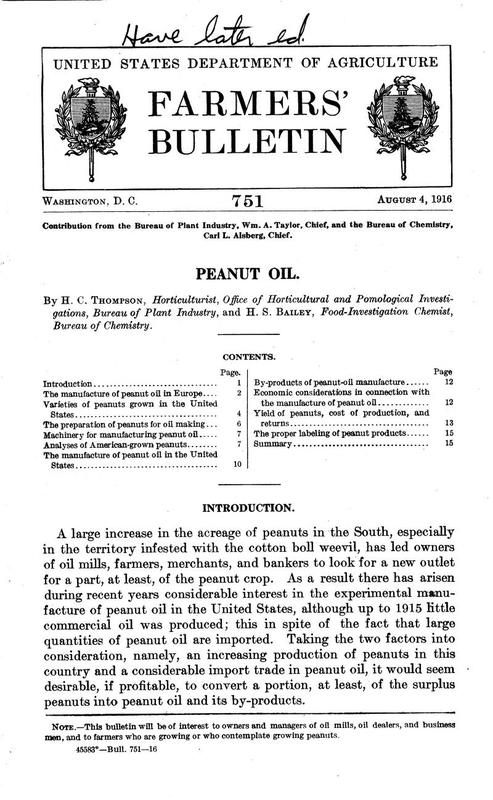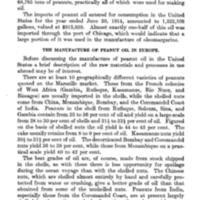Peanut Oil
Date
1916
Excerpt
A large increase in the acreage of peanuts in the South, especially in the territory infested with the cotton boll weevil, has led owners of oil mills, farmers, merchants, and bankers to look for a new outlet for a part, at least, of the peanut crop. As a result there has arisen during recent years considerable interest in the experimental manufacture of peanut oil in the United States, although up to 1915 little commercial oil was produced; this in spite of the fact that large quantities of peanut oil are imported. Taking the two factors into consideration, namely, an increasing production of peanuts in this country and a considerable import trade in peanut oil, it would seem desirable, if profitable, to convert a portion, at least, of the surplus peanuts into peanut oil and its by-products.
Peanut oil is one of the most important of the world's food oils, as is evidenced by the fact that in 1912 over 120,000 metric tons of peanuts in the shell, together with about 240,000 metric tons of shelled nuts, were crushed in Marseille, yielding 15,500,000 gallons of edible oil. In addition to this, about 23,000,000 gallons of inedible peanut oil were produced. The same year, Germany imported 68,765 tons of peanuts, practically all of which were used for making oil.
The imports of peanut oil entered for consumption in the United States for the year ended June 30, 1914, amounted to 1,332,108 gallons, valued at $915,939. Almost exactly one-half of this oil was imported through the port of Chicago, which would indicate that a large portion of it was used in the manufacture of oleomargarine.
Peanut oil is one of the most important of the world's food oils, as is evidenced by the fact that in 1912 over 120,000 metric tons of peanuts in the shell, together with about 240,000 metric tons of shelled nuts, were crushed in Marseille, yielding 15,500,000 gallons of edible oil. In addition to this, about 23,000,000 gallons of inedible peanut oil were produced. The same year, Germany imported 68,765 tons of peanuts, practically all of which were used for making oil.
The imports of peanut oil entered for consumption in the United States for the year ended June 30, 1914, amounted to 1,332,108 gallons, valued at $915,939. Almost exactly one-half of this oil was imported through the port of Chicago, which would indicate that a large portion of it was used in the manufacture of oleomargarine.
Title
Peanut Oil
File(s)
Peanut Oil 1.jpg
(image/jpeg)
Peanut Oil 2.jpg
(image/jpeg)
 An official website of the United States government.
An official website of the United States government.



